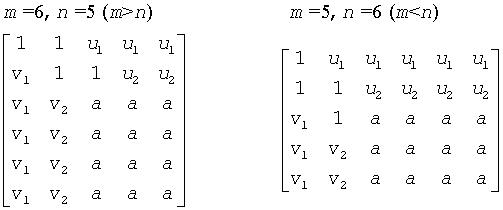Developer Reference for Intel® oneAPI Math Kernel Library for Fortran
A newer version of this document is available. Customers should click here to go to the newest version.
Visible to Intel only — GUID: GUID-50D31EBC-E6F9-4F68-BFB0-005E9E65E9BC
Visible to Intel only — GUID: GUID-50D31EBC-E6F9-4F68-BFB0-005E9E65E9BC
?labrd
Reduces the first nb rows and columns of a general matrix to a bidiagonal form.
Syntax
call slabrd( m, n, nb, a, lda, d, e, tauq, taup, x, ldx, y, ldy )
call dlabrd( m, n, nb, a, lda, d, e, tauq, taup, x, ldx, y, ldy )
call clabrd( m, n, nb, a, lda, d, e, tauq, taup, x, ldx, y, ldy )
call zlabrd( m, n, nb, a, lda, d, e, tauq, taup, x, ldx, y, ldy )
Include Files
- mkl.fi
Description
The routine reduces the first nb rows and columns of a general m-by-n matrix A to upper or lower bidiagonal form by an orthogonal/unitary transformation Q'*A*P, and returns the matrices X and Y which are needed to apply the transformation to the unreduced part of A.
if m≥n, A is reduced to upper bidiagonal form; if m < n, to lower bidiagonal form.
The matrices Q and P are represented as products of elementary reflectors: Q = H(1)*(2)* ...*H(nb), and P = G(1)*G(2)* ...*G(nb)
Each H(i) and G(i) has the form
H(i) = I - tauq*v*v' and G(i) = I - taup*u*u'
where tauq and taup are scalars, and v and u are vectors.
The elements of the vectors v and u together form the m-by-nb matrix V and the nb-by-n matrix U' which are needed, with X and Y, to apply the transformation to the unreduced part of the matrix, using a block update of the form: A := A - V*Y' - X*U'.
This is an auxiliary routine called by ?gebrd.
Input Parameters
- m
-
INTEGER. The number of rows in the matrix A (m≥ 0).
- n
-
INTEGER. The number of columns in A (n≥ 0).
- nb
-
INTEGER. The number of leading rows and columns of A to be reduced.
- a
-
REAL for slabrd
DOUBLE PRECISION for dlabrd
COMPLEX for clabrd
DOUBLE COMPLEX for zlabrd.
Array a(lda,*) contains the matrix A to be reduced. The second dimension of a must be at least max(1, n).
- lda
-
INTEGER. The leading dimension of a; at least max(1, m).
- ldx
-
INTEGER. The leading dimension of the output array x; must beat least max(1, m).
- ldy
-
INTEGER. The leading dimension of the output array y; must beat least max(1, n).
Output Parameters
- a
-
On exit, the first nb rows and columns of the matrix are overwritten; the rest of the array is unchanged.
if m≥n, elements on and below the diagonal in the first nb columns, with the array tauq, represent the orthogonal/unitary matrix Q as a product of elementary reflectors; and elements above the diagonal in the first nb rows, with the array taup, represent the orthogonal/unitary matrix p as a product of elementary reflectors.
if m < n, elements below the diagonal in the first nb columns, with the array tauq, represent the orthogonal/unitary matrix Q as a product of elementary reflectors, and elements on and above the diagonal in the first nb rows, with the array taup, represent the orthogonal/unitary matrix p as a product of elementary reflectors.
- d, e
-
REAL for single-precision flavors
DOUBLE PRECISION for double-precision flavors. Arrays, DIMENSION (nb) each. The array d contains the diagonal elements of the first nb rows and columns of the reduced matrix:
d(i) = a(i,i).
The array e contains the off-diagonal elements of the first nb rows and columns of the reduced matrix.
- tauq, taup
-
REAL for slabrd
DOUBLE PRECISION for dlabrd
COMPLEX for clabrd
DOUBLE COMPLEX for zlabrd.
Arrays, DIMENSION (nb) each. Contain scalar factors of the elementary reflectors which represent the orthogonal/unitary matrices Q and P, respectively.
- x, y
-
REAL for slabrd
DOUBLE PRECISION for dlabrd
COMPLEX for clabrd
DOUBLE COMPLEX for zlabrd.
Arrays, dimension x(ldx, nb), y(ldy, nb).
The array x contains the m-by-nb matrix X required to update the unreduced part of A.
The array y contains the n-by-nb matrix Y required to update the unreduced part of A.
Application Notes
if m≥n, then for the elementary reflectors H(i) and G(i),
v(1:i-1) = 0, v(i) = 1, and v(i:m) is stored on exit in a(i:m, i); u(1:i) = 0, u(i+1) = 1, and u(i+1:n) is stored on exit in a(i, i+1:n);
tauq is stored in tauq(i) and taup in taup(i).
if m < n,
v(1:i) = 0, v(i+1) = 1, and v(i+1:m) is stored on exit in a(i+2:m, i) ; u(1:i-1) = 0, u(i) = 1, and u(i:n) is stored on exit in a(i, i+1:n); tauq is stored in tauq(i) and taup in taup(i).
The contents of a on exit are illustrated by the following examples with nb = 2:

where a denotes an element of the original matrix which is unchanged, vi denotes an element of the vector defining H(i), and ui an element of the vector defining G(i).